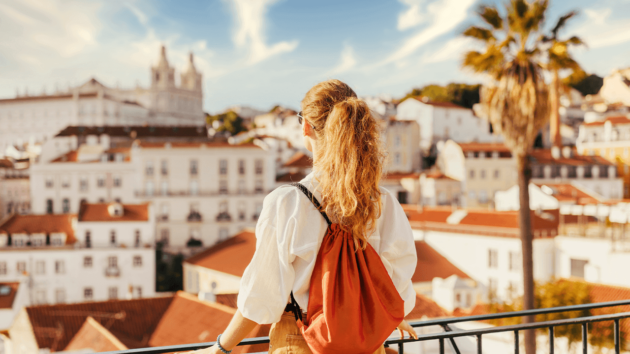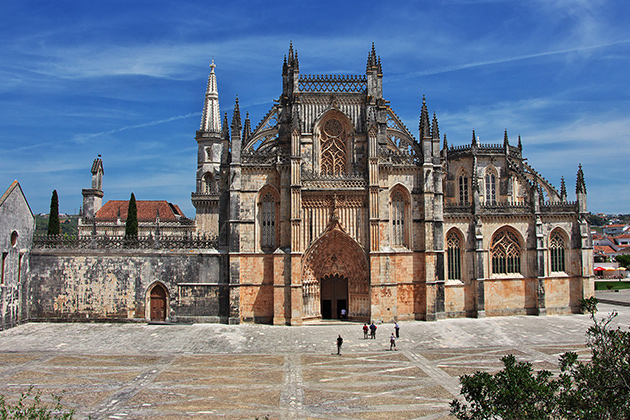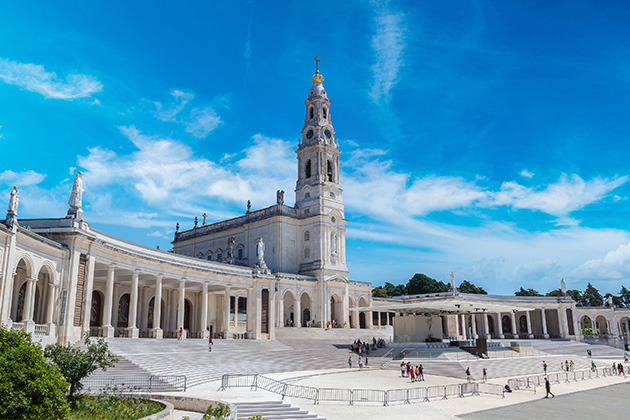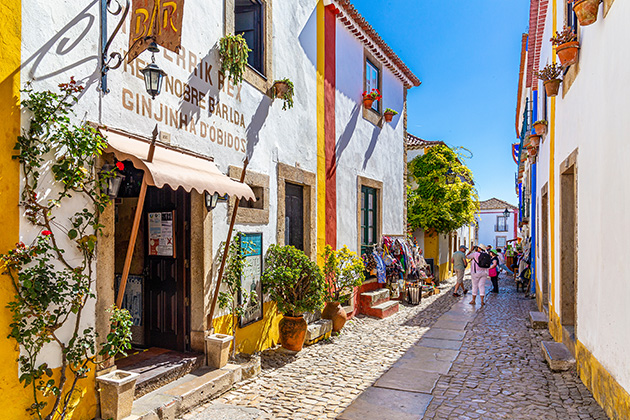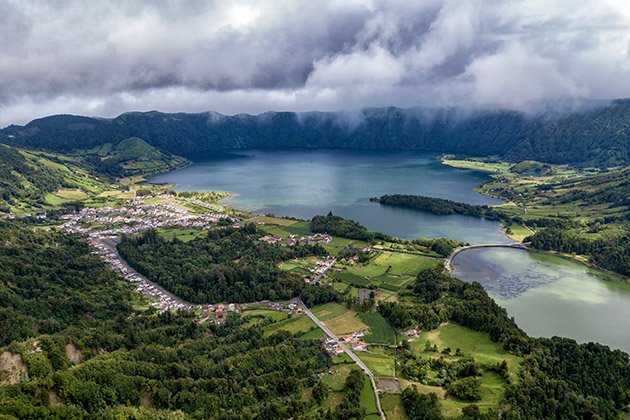
In this article we provide you with suggestions to visit the Azores. If you have already settled in mainland Portugal and you feel you have a good grasp of your surroundings, then maybe the time has come to hop over to the archipelago of the Azores, with its nine islands, divided into three different groups.
Visit the Azores: what not to miss
Eastern Group
São Miguel Island
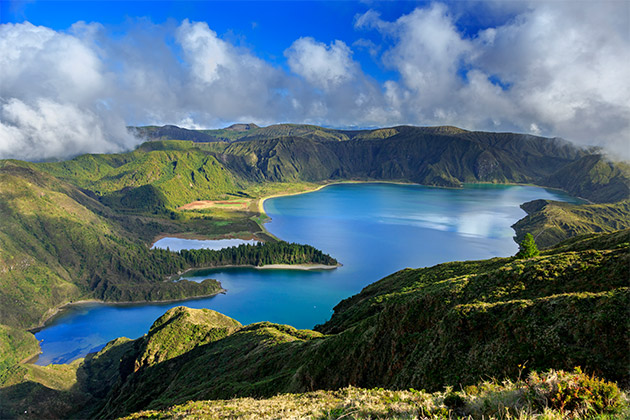
If you want to visit the Azores and you’re starting with São Miguel, begin with a climb up to the Castelo Branco Belvedere, from where you can an absolutely unforgettable panoramic view over most of the Western side of the island of São Miguel, the Lagoa das Furnas and Vila Franca do Campo. At the Furnas make sure not to miss the fumaroles and the geysers and to try the famous bolos lêvedos and the Furnas cozido, which you can even help prepare.
Make sure to take advantage of the free admission to the Ribeira dos Caldeirões Natural Park. Here you will find waterfalls, watermills, a botanical garden and an ethnographic museum which is worth visiting. At the Lagoa do Fogo you can enjoy one of the most breath-taking views over the whole archipelago, from the Serra da Barrosa Belvedere.
And on the topic of natural beauty, you won’t want to miss Vista do Rei, from where, on a clear day, you can see the Lagoa das Sete Cidades. Make sure to also visit Sete Cidades itself, a small village next to Lagoa Azul, where you can appreciate the Neo-gothic Church of S. Nicolau.
Make sure, also, to visit the Caldeira Velha, with its hot waterfall which runs down the volcanic rocks to form a small lagoon. The Mosteiros Beach is one of the most beautiful in São Miguel, and also a must.
The capital of the Azores, Ponta Delgada, also merits your attention. With its whitewashed walls, sidewalks paved with traditional black basaltic rocks, the city calls for a stroll along the seaside road. Make your way to the City Hall’s Bell Tower, which dates to the XVIII Century, for a great view of the city.
Being the capital of the whole archipelago, here you will be able to take in some of the most important monuments, such as the São Brás Fortress, the Espírito Santo and São José churches, the Convento da Esperança, the Main Church, the city gates and the Palácio da Conceição, with its several chapels spread all over the city.
Santa Maria Island
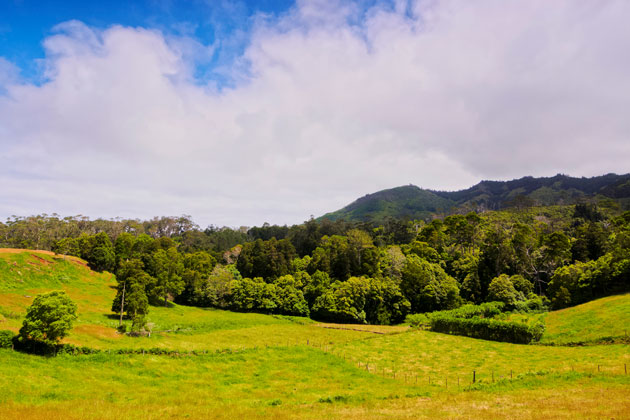
If you visit the Azores, don’t miss Santa Maria. With their absolutely stunning conditions, the Formigas Natural Reserve, the Dollabarat Reef and the Baixa do Ambrósio make Santa Maria a prime location for those who love diving. Depending on the spots, you will be able to see rays, tuna, turtles and schools of bluejack mackerels or even perfectly harmless whale sharks.
At around 100 meters tall, the Aveiro waterfall, located in Maia, on the southeast side of the island, is one of the most beautiful spots in Santa Maria. This is a sight you’ll not soon forget. Once you are there, enjoy the adjacent lagoons.
Make sure to visit Terra do Raposo, in Santo Espírito, also on the southeast of the island – it is worth it for the houses, which have kept their original style, but also for the local way of life, which remains unchanged since the early ages of the community, when people from the Alentejo and the Algarve settled there and maintained the traditional coloured outline on door and window frames which has become a characteristic of the island. Terra do Raposo is, above all, a journey to the roots of the island and its traditions.
Finally, Barreiro da Faneca is another point on the island which you shouldn’t miss. It was declared protected landscape of regional interest because of the expanse of arid clay-based earth which makes it a yellow and red semi-desert.
Visit the Azores: Central Group
Terceira Island
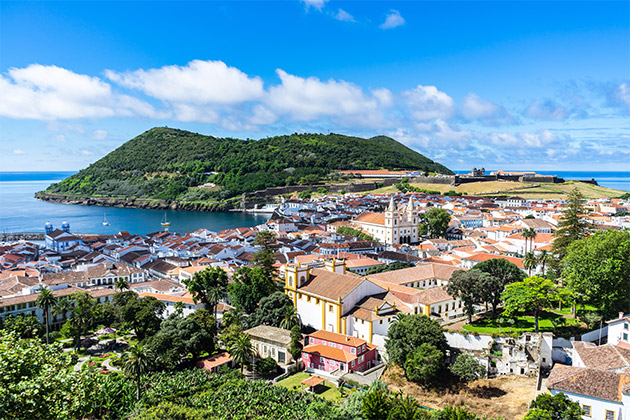
You can’t visit Terceira Island without exploring the lovely capital Angra do Heroísmo, classified as UNESCO World Heritage since 1983. History speaks out from every corner of its traditional streets, which seduce traders and travellers alike.
The richness of the monuments and different buildings is one of the calling cards of Angra do Heroísmo, with pride of place going to the lordly houses and palaces such as Bettencourt Palace. The Cathedral, the São Gonçalo Convent and the Misericórdia are spots which you cannot miss.
Located on the East side of the island, the city of Praia da Vitória takes pride in having the largest bay in the Azores, surrounded by a stunning landscape which you will want to see. Steeped in history, this was one of the first settlements on the island and a visit to the historic centre is a must. Here the Main Church, the Santa Catarina Fortress, the Senhor Santo Cristo Church and the Nossa Senhora dos Remédios and São Lázaro chapels make up the list of top spots to see.
If you are interested in becoming acquainted with the island’s important agricultural tradition and rural heritage, then you’ll need to visit Vila das Lages. For centuries, Vila das Lages was known as the granary of the island. Cereal production has since ceased with the construction of the Lages Air Force base during the Second World War. We also suggest a visit to Caldeira das Lages, known for its wine production.
Finally, you can’t leave without visiting the Cabras islets, just in front of Feiteira, which are classified as a Special Protected Zone. These are the largest islets of the Azores and are breeding grounds for protected species such as the corey’s shearwater, the roseate tern and the capped heron.
São Jorge Island
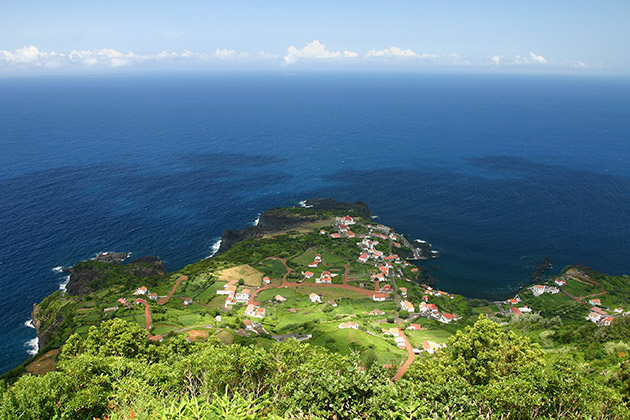
São Jorge should be one of your stops in your visit to Azores. Velas, with its rural and fishing atmosphere, is on the south side of the island, near a gorgeous and lush inlet. The architectural heritage is also one of the town’s strong points, especially the XVII Century Main Church and the Nossa Senhora do Pilar Fortress. Relax and go for a walk in the Praça da República Park, one of the most beautiful in the country, and then along to the Largo do Mercado.
You should also make sure to take the opportunity to visit the Fajã da Caldeira de Santo Cristo, located in Ribeira Seca, on the Northern coast of the island. Famous among surfers and bodyboarders, it enjoys the status of Nature Reserve, being home to several important species of flora and fauna. Take advantage of your stay to appreciate the calm, warm waters before taking a dip into the Santo Cristo Chapel.
Of course you can’t leave São Jorge without trying some of the local cheese, bought straight from the producer, following a visit to a cooperative. The same goes for the famous Santa Catarina tuna preserves, which are produced here. You’ll find a wider range, and at much more competitive prices, than in mainland Portugal.
Pico Island
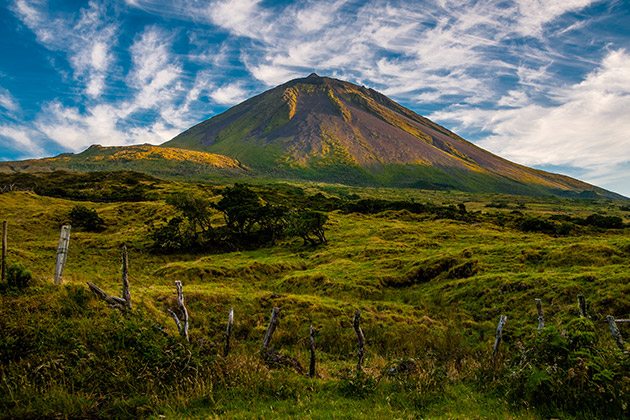
This is the second largest island on the archipelago and includes the highest point in Portugal, Pico Mountain, the peak of which, Piquinho, stands at an impressive 2351 meters above sea level. Accept our challenge to roll back your sleeves, move those legs and make it up to the top. It will be an unforgettable experience!
The introduction of vines changed the landscape and the Western culture of the island, which has been recognised as World Heritage. We suggest you dedicate some time to tasting the wines, especially the famous Verdelho, as well as the reds and whites. At the Wine Museum, in Madalena, you can learn much more about the famous wines the island still produces.
Whaling was very popular on the island, and shaped the way of life of the inhabitants, so you can’t miss a visit to the Whalers Museum, in Lages do Pico, to become more familiar with the local traditions in this paradise. The development of the industry owed a lot to the presence of Americans on the Island, but over time whaling was gradually replaced with dolphin and whale watching, which is also a must.
The island is also very rich in terms of food, and we suggest you try the delicious seafood, especially the fish stews, but also the São João and Arrife cheeses.
Faial Island
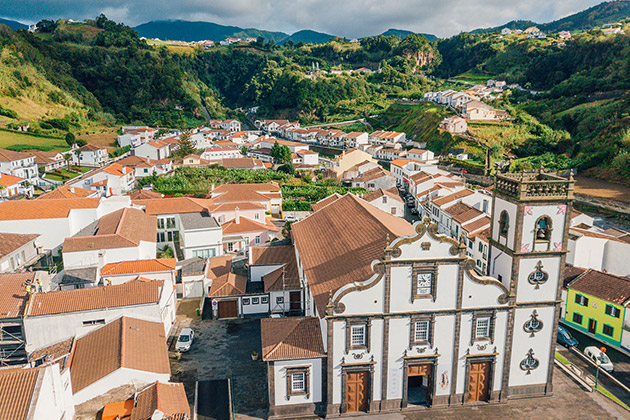
The cosmopolitan and international city of Horta is a mandatory stop if you visit the Azores. Located on the bay, it overhangs the marina, which receives a large number of recreational boats. We seriously suggest you visit the rich architectural heritage, such as the Main Church of São Salvador and the Church of São Francisco, the Porto Pim fortress and the Clock Tower.
Once you’re here, you absolutely must visit the Capelinhos Volcano, the last eruption of which took place in 1957 and completely reshaped the landscape, giving rise to arid and volcanic terrain. The volcano kept active for 13 months, leading much of the population to emigrate to the USA.
For a better look you should head to the Lighthouse, from which you will have a panoramic view. Climbing it makes for an amazing hike, but which can be dangerous, so we recommend you follow the set paths or hire an official guide.
If it’s a day of beaching and surfing that you are after, then make your way to the Praia do Norte. Sandwiched between cliffs, it is famous among surfers and is an absolutely stunning place, as beautiful as the Almoxarife beach, if not more. This is one of the largest expanses of sand on the island, and commands a great view of the Pico.
Meanwhile, make sure to visit the famous Peter Café Sport and the Scrimshaw Museum, in Horta. The century old café has become famous all over the world, especially among sailors. You’ll hear lots of stories over a glass of rum, a whisky or gin and tonic, and experience a true sailing and Atlantic adventure atmosphere. The museum has one of the most beautiful scrimshaw collections in the world, that is the technique of engraving illustrations on whale tooth ivory.
Graciosa Island
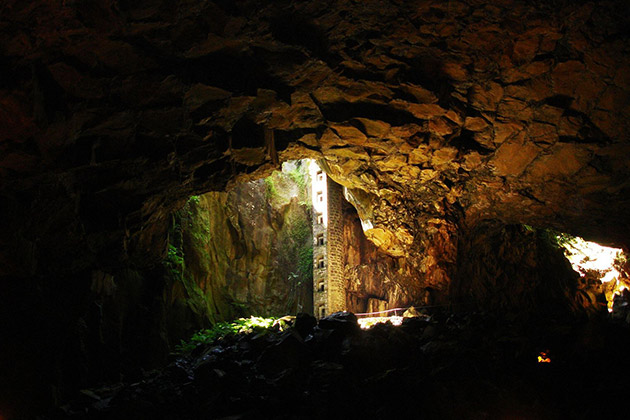
If you visit Graciosa Island you can’t miss a trip to the Caldeira and the Furna do Enxofre, only accessible through a spiralling 183 step staircase. It is such a dramatic scenario that it captured the interest of King D. Carlos I and even Prince Albert I of Monaco, who explored it suspended only from a rope.
However, you can opt for the easier 10 km hiking trail, on the outside of the volcano crater. Make sure to try (and stock up on) the famous Graciosa Queijadas. You can do so at the very factory that produces them, and goes by the same name, from its plant in Canada Nova.
You might also enjoy the rice cakes and the local biscuits. Very close by you can watch the windmills which used to grind the grain, when the island was the largest exporter in the archipelago, but now serve as summer houses. They are originally Scandinavian, reminding one of the arrival of the Nordic families which initially set up in São Miguel, before making their way to Graciosa.
A visit to the local cooperative will also provide you with the opportunity to try and purchase some of the traditional products on the island, among which the famous Pedras Brancas brandy and, nowadays, other red and white wines by that same producer
Visit the Azores: Western Group
Corvo island
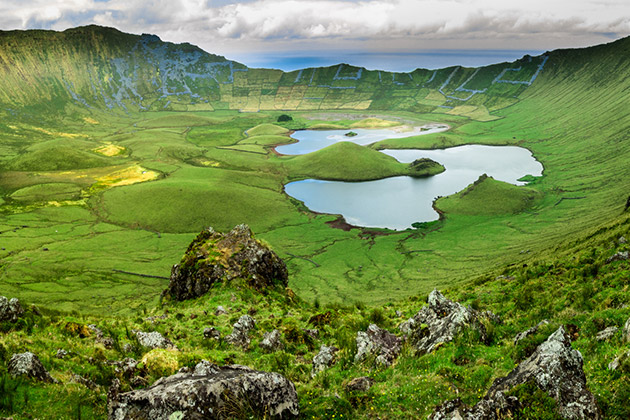
Corvo Island is classified as a Biosphere Reserve by UNESCO. If you want to understand why, then you need to visit the Caldeirão Belvedere, from where you can enjoy an unforgettable view.
Birdwatching enthusiasts come here from all over the world, to such an extent that the local hotels are often fully booked by the time the birds stop to rest from their Atlantic migrations.
There is only one settlement on the island, Vila Nova do Corvo, and you can’t leave without taking a stroll through the old part of town, to become better acquainted with the true treasure of the island: its inhabitants. The people have a strong tradition of solidarity, a throwback to the days when, in times of emergency, they would light fires on the top of the hill to communicate with the neighbouring Flores Island. The number of bonfires would indicate if they needed a doctor or a priest.
Flores Island
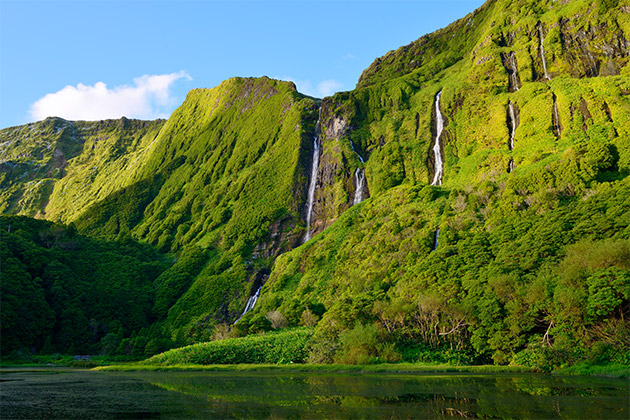
If you visit the Azores, you could include Flores in your tour. This is a largely mountainous island, with large ravines and impressive cliffs. The Flores Island is covered by thousands of hydrangeas which make for an amazing landscape, flooding the fields and hanging over the margins of the lagoons and streams. Along with Graciosa and Corvo, this island is also part of the UNESCO biosphere network.
Santa Cruz das Flores is the largest settlement on the island, and from there you can easily reach the Costa Nordeste Belvedere, with its overwhelming view over the ocean. This is where the Ilha Uniflores Cheese is produced, along with the Artisanal Butter, which will delight even the most demanding gourmet.
We recommend a visit to the island’s lagoons, which spread from the Santa Cruz road to the Fajã Grande. The most impressive are the Lomba, Rasa, Funda, Negra and Comprida. Make sure also to go to the Poço do Bacalhau, where you can bathe in a waterfall, surrounded by a lovely landscape.
Don’t miss the opportunity to visit the Natural Pools in Salema and Fajâzinha, a charming village which spans the Ribeira Grande and where time seems to have stood still. While you are at it do some shopping at the Pico Redondo Cheese Shop and eat at a local restaurant, with its rustic appeal and delicious traditional dishes, using produce straight out of the earth.
